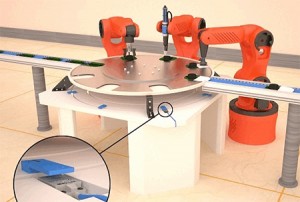Contrinex inductive sensors speed up PCB production
 Automated assembly systems are increasingly used for high volume assembly operations because of their ability to remove labour and also eliminate the potential of assembly errors. Rugged inductive sensors from Contrinex help provide fault-free assembly and minimise downtime by reliable detecting the presence and position of equipment or components, ensuring that parts are correctly aligned and ready for the next operation. In addition to providing accurate, reliably and fast switching the sensors also provide an IO-Link interface which offers the advantages of digital communication without the need for special cabling.
Automated assembly systems are increasingly used for high volume assembly operations because of their ability to remove labour and also eliminate the potential of assembly errors. Rugged inductive sensors from Contrinex help provide fault-free assembly and minimise downtime by reliable detecting the presence and position of equipment or components, ensuring that parts are correctly aligned and ready for the next operation. In addition to providing accurate, reliably and fast switching the sensors also provide an IO-Link interface which offers the advantages of digital communication without the need for special cabling.
In one particular application, automated systems are used to improve the efficiency and reliability of assembly operations and often enable the elimination of assembly faults. Whilst the repetitive assembly tasks are ideally suited to be done by robots, a common bottleneck in production is that these robots can be too slow at picking and placing the assembled parts and therefore in this application a rotary indexing table is used to move the assemblies between the robots.
The rotary indexing table speeds up the transfer of PCBs between assembly robots and also on and off conveyors, increasing the production throughput and reducing the number of assembly robots required. Sensors are used to automate these processes and these sensors must be able to operate continuously at high speed, performing tasks including: presence detection to initiate the cassette-change cycle in a stack feeder; position control for a rotary indexing table; pick-and-place gripper control; and presence monitoring on a conveyor system.
Stack-feeders deliver base plates, electrical printed circuit boards and other planar components to the assembly lines. In each stack-feeder, a vertical cassette holds as many as 50 individual parts and a single inductive sensor monitors the status of each cassette. Once the final part is discharged from the stack, the cassette moves to its end position, triggering the sensor and initiating the cassette-change cycle.
Contrinex C23 embeddable inductive sensors, featuring a one-piece stainless-steel housing, are both robust and highly reliable. A 7mm sensing distance allows ample operating clearance, minimizing the risk of mechanical collision. Their implementation into the assembly equipment is made easier by the choice of industry-standard PNP or NPN outputs with either a PUR cable or an M8 pigtail connector. Additionally, IO-Link, a standardised point-to-point serial connection protocol for sensors and actuators, is provided at no additional cost, offering the advantages of digital communication without the need for special cabling, making them ideal for Industry 4.0 applications.
Designed for demanding applications, Contrinex’s rugged C23 inductive sensors offer best-in-class switching frequency of 180Hz and exceptional robustness including impact and abrasion resistance, making them a versatile, cost-effective and highly reliable solution. These uniquely robust sensors are typically demonstrated by Contrinex as being able to repeatedly being used to hammer in nails. Even when their front face is dented, the sensor continues to operate correctly.
Conveyors deliver a continuous stream of parts to the rotary indexing table, which transports them in sequence to each assembly station. As the table rotates, sensors located at precise intervals around its periphery detect its exact angular position, bringing it to a halt once parts are correctly positioned for the next operation.
At each assembly station, automated pick-and-place equipment adds components to the assembly. Dedicated transport mechanisms – including vacuum lifters, electromagnetic clamps and mechanical grippers – insert items swiftly and accurately in their designated positions. Embeddable inductive sensors play a key role in confirming the secure closure of custom-designed grippers before fragile, high-value parts are lifted.
Manufactured in V4A/ AISI 316L stainless steel and rated to IP68/ IP69K, these small inductive sensors can be fully embedded into a steel surface such as part of the rotary table or an assembly jig or bench, further reducing the potential for mechanical damage.
On completion of the final assembly stage, finished PCBs are discharged to a linear conveyor system. They travel to subsequent processing stages, including testing and packing. C23 Full stainless steel sensors mounted directly above these conveyors, detect each unit as it passes below. This check not only confirms the presence of the assembled item at the expected height above the conveyor but also measures throughput by activating a counting circuit in the customer’s control system.
Continuous operation is the norm in automated assembly plants. However, minor adjustments or tool changes may be required from time to time. In non-safety-critical areas, access hatches allow maintenance technicians to carry out these tasks without needing to interrupt production across an entire plant. Multiple sensors, mounted at intervals around the periphery of a hatch, ensure that appropriate warning signals are activated whenever the opening is not fully secured.
Contrinex sensors are available in the UK from Plus Automation. Visit the Plus Automation website for more information















